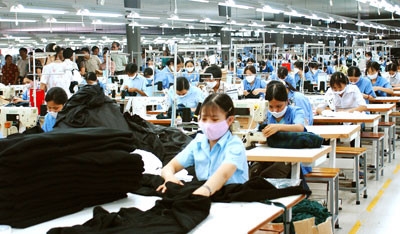 Society
Society

Việt Nam’s rate of non-compliance with the minimum wage in the garment, textile and footwear sector is the lowest among seven garment-exporting countries in Asia, at 6.6 per cent, accordint to a new report by the International Labor Oeganization (ILO).
 |
| Việt Nam’s rate of non-compliance with the minimum wage in the garment, textile and footwear sector is the lowest among seven garment-exporting countries in Asia, at 6.6 per cent, according to a new report by the International Labor Organisation (ILO). — Photo thoibao.today |
HÀ NỘI — Việt Nam’s rate of non-compliance with the minimum wage in the garment, textile and footwear sector is the lowest among seven garment-exporting countries in Asia, at 6.6 per cent, according to a new report by the International Labor Organisation (ILO).
This rate is far better than the second lowest country on the list – Cambodia at 25.6 per cent, and almost nine times lower than the top-ranked violator – the Philippines, at 53.3 per cent.
The rate of extreme non-compliance in Việt Nam, which means wageworkers are paid less than four-fifths of the minimum wage in the country, is 3.8 per cent and moderate non-compliance (workers paid between 80 per cent and less than 100 per cent of the minimum wage) is 2.8 per cent.
In contrast, the Philippines, India, Thailand, Pakistan, and Indonesia each have a large proportion of garment sector workers who are paid far below the minimum wage. The extreme non-compliance rate in the Philippines and India is 38.8 and 34.9 per cent, respectively. About one fourth of Indonesian garment workers also earn far below the minimum wage.
“The depth of non-compliance is an important dimension because a worker being paid 99 per cent of the minimum is in a very different situation to one receiving only half of the minimum,” said Matthew Cowgill, ILO chief technical adviser on labour standards in the global supply chain, who is the lead author of the report.
In all the countries, women are more likely than men to be paid below the minimum wage in the garment sector. Again, Việt Nam is among the nations with the smallest male-female gaps (at 5.7 percentage points), behind Cambodia and Indonesia, whereas the largest male-female non-compliance gap is found in Pakistan (60.4 per cent).
According to the report, the design of minimum wage systems, including the minimum wage rate and the complexity of the wage structure, are important considerations for improving compliance.
Việt Nam has four regional minimum wages, ranging from VNĐ2.4 to 3.5 million (US$108–157) a month. The minimum wage levels are decided annually by the National Wage Council that includes representatives the Government, employers’ and workers’ organisations.
While praising the compliance rate in Việt Nam’s growing garment, textile and footwear sector, ILO Việt Nam Director Chang-Hee Lee warned that data should be interpreted with caution..
The Việt Nam data used in the study dates back to 2013, whereas minimum wage had significantly increased in the previous three years. New data is needed to see if the high compliance continues even with the significantly increased minimum wages, he said.
Việt Nam’s regional minimum wages increased by about 12-15 per cent on a yearly basis between 2014 and 2016 and will go up by 7.3 per cent next year. — VNS